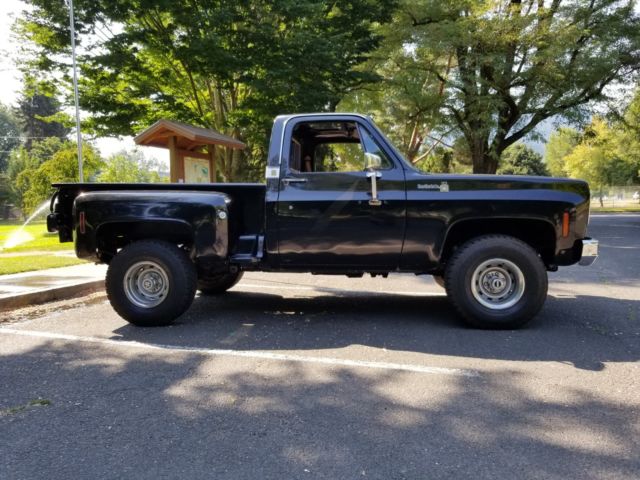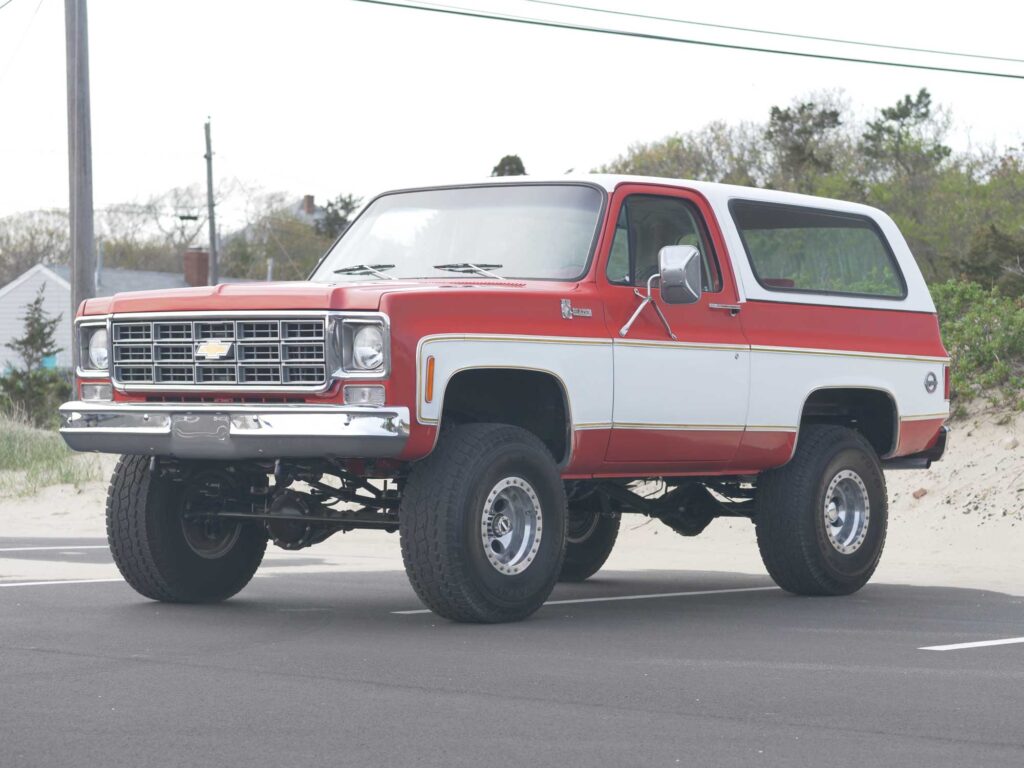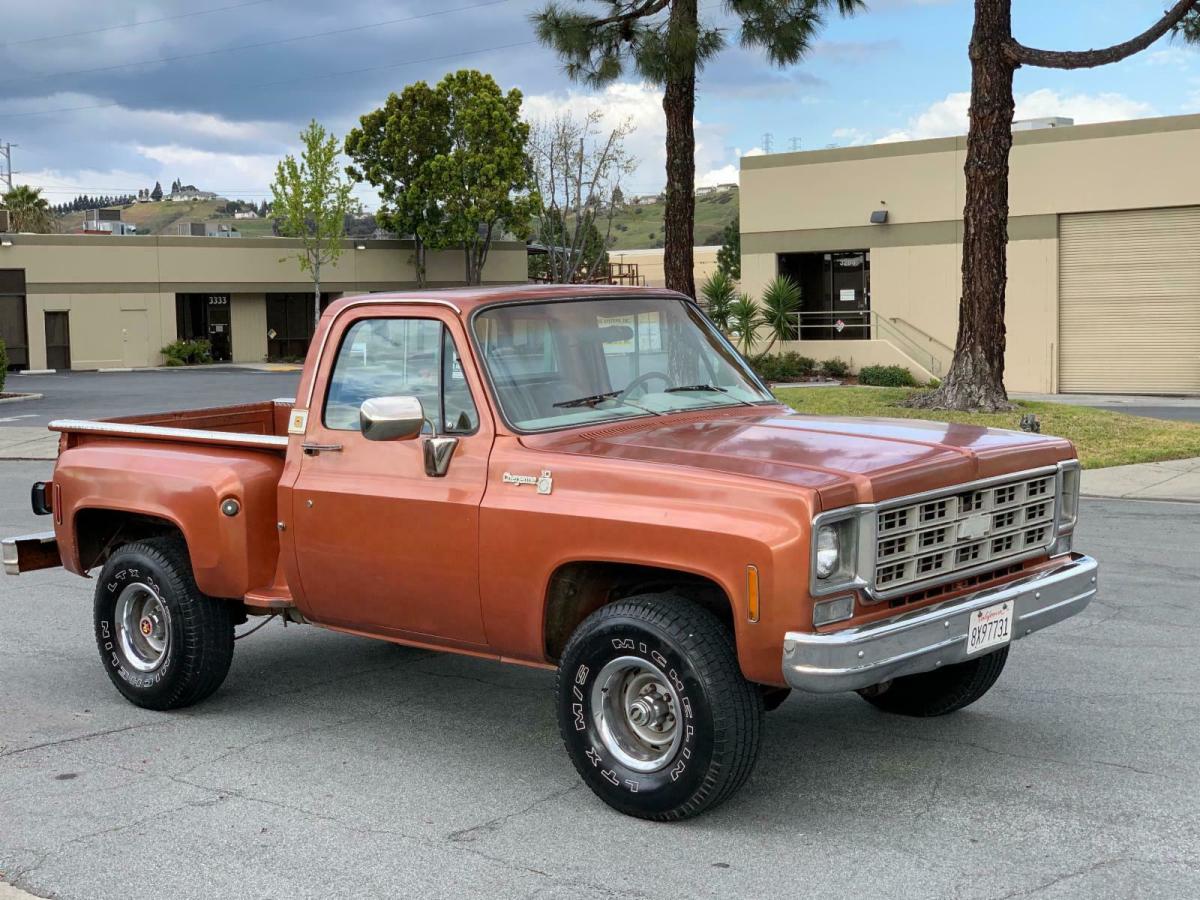1977 Chevy 4×4 Trucks For Sale: A Comprehensive Buyer’s Guide pickup.truckstrend.com
Introduction: The Unyielding Allure of the 1977 Chevy 4×4
In the realm of classic American trucks, few vehicles command as much respect and admiration as the "Square Body" Chevrolet C/K series, and among them, the 1977 Chevy 4×4 stands as a true icon. More than just a utility vehicle, these trucks embody a rugged simplicity, a no-nonsense design, and an undeniable cool factor that continues to captivate enthusiasts and collectors alike. Whether you’re a seasoned off-roader, a classic car aficionado, or simply someone looking for a dependable and stylish vintage hauler, the prospect of finding a 1977 Chevy 4×4 for sale opens the door to a world of adventure, nostalgia, and a tangible piece of automotive history.
1977 Chevy 4×4 Trucks For Sale: A Comprehensive Buyer’s Guide
The 1977 model year falls right in the sweet spot of the third-generation C/K series (1973-1987), often referred to as the "Square Body" era. These trucks represent a significant leap forward in comfort and styling from their predecessors, while retaining the legendary durability and straightforward mechanicals that made Chevy trucks famous. For many, the ’77 4×4 is the quintessential American pickup – capable, robust, and possessing a timeless aesthetic that has only grown stronger with age. This comprehensive guide will delve into everything you need to know about these coveted machines, from their key features to what to look for when buying, and how to maintain your piece of classic Americana.
The Enduring Appeal of the 1977 Chevy 4×4
The Square Body generation of Chevrolet trucks revolutionized the pickup market with its more car-like interior, improved ride quality, and distinctive, angular styling. The 1977 model year specifically benefited from a few years of refinement since the 1973 redesign, meaning many of the initial kinks had been worked out, yet it predates some of the later, more emissions-choked engines, offering a blend of classic character and reliable performance.
What makes the 1977 Chevy 4×4 so desirable today?
- Iconic Styling: The clean lines, prominent grille, and sturdy proportions define the "tough truck" aesthetic. They look just as good lifted on modern tires as they do restored to factory specifications.
- Robust Construction: Built when trucks were truly workhorses, these vehicles feature heavy-duty frames, durable drivetrains, and simple, repairable mechanicals.
- Mechanical Simplicity: Unlike modern trucks laden with complex electronics, the ’77 Chevy 4×4 is largely mechanical, making it easier for the average enthusiast to diagnose, repair, and maintain.
- Versatility: From a daily driver to a dedicated off-road rig, a show truck, or a farm workhorse, the 1977 Chevy 4×4 can be adapted to almost any purpose.
- Strong Aftermarket Support: Due to their popularity, parts availability for these trucks is excellent, ranging from reproduction body panels to performance upgrades.
- Nostalgia Factor: For many, these trucks evoke memories of a simpler time, representing freedom, hard work, and classic American engineering.

Key Features and Specifications of the 1977 Chevy 4×4

Understanding the various configurations and components of the 1977 Chevy 4×4 is crucial for any potential buyer. These trucks were offered in a range of options to suit different needs.
Engine Options
- Small Block V8s:
- 305 cu in (5.0L) V8: A common choice, offering a balance of power and efficiency (for the era).
- 350 cu in (5.7L) V8: The legendary "small block Chevy," widely available and highly sought after for its robust performance, tunability, and abundant aftermarket support. This is arguably the most common and desirable engine.

- Big Block V8:
- 454 cu in (7.4L) V8: The powerhouse option, offering massive torque and horsepower, ideal for heavy towing or performance builds. Less common in 4x4s but highly desirable.
Transmission Options
- Manual Transmissions:
- SM465 (Saginaw Muncie 465) 4-speed manual: A heavy-duty, notoriously tough transmission with a very low "granny" first gear, perfect for off-roading or heavy hauling.
- Automatic Transmissions:
- TH350 (Turbo-Hydramatic 350) 3-speed automatic: Common with smaller V8s, reliable and compact.
- TH400 (Turbo-Hydramatic 400) 3-speed automatic: A beefier version of the TH350, typically paired with the 454 V8 or in heavy-duty applications, known for its extreme durability.
Transfer Cases
The transfer case is what allows the truck to switch between two-wheel drive (2WD) and four-wheel drive (4WD).
- NP203 (New Process 203) Full-Time 4×4: Standard on many 1977 K-series trucks. This system operates in 4WD all the time, using a differential within the transfer case to allow for varying wheel speeds, making it suitable for paved roads. However, it can be less fuel-efficient and some enthusiasts prefer part-time systems. Many NP203s were later converted to part-time operation or swapped out entirely.
- NP205 (New Process 205) Part-Time 4×4: While the NP203 was more common, the NP205 was also available or often swapped in. This robust, gear-driven transfer case offers true part-time 4WD, meaning you engage 4WD only when needed (e.g., off-road, snow), providing better fuel economy and less drivetrain wear on pavement. It’s considered more desirable by serious off-roaders.
Axles
- Front Axle: Typically a Dana 44, known for its strength and widespread use.
- Rear Axle: Usually a GM 10-bolt or 12-bolt, depending on the truck’s Gross Vehicle Weight Rating (GVWR) and application. K20 (3/4-ton) models often had a heavier-duty 14-bolt rear axle.
Body Styles
The 1977 Chevy 4×4 was available in several configurations:
- K10 (1/2-ton): The most common and popular, available as a regular cab short bed, regular cab long bed, or occasionally a crew cab.
- K20 (3/4-ton): Heavier duty, with a stronger frame, axles, and suspension, designed for heavier loads and towing.
- K30 (1-ton): The heaviest duty, often seen as a cab and chassis for utility bodies or dually setups. Less common as a standard pickup.
- K5 Blazer: The full-size SUV variant, essentially a short-wheelbase K10 with a removable top, highly sought after.
- Suburban: The full-size SUV with four doors, offering ample passenger and cargo space, also available in 4×4.
What to Look For When Buying a 1977 Chevy 4×4
Purchasing a vintage truck requires a keen eye and a thorough inspection. These trucks are nearly 50 years old, and condition varies wildly.
- Rust, Rust, Rust: This is the absolute biggest enemy of Square Body trucks.
- Cab Corners & Rocker Panels: These are notorious rust traps due to poor drainage.
- Floorboards: Check under the carpet and mats, especially near the kick panels and seat mounts.
- Bed: Inspect the bed floor (especially under the mat if present), wheel wells, and bed sides.
- Fenders & Hood: Look for bubbling paint or perforations.
- Frame: Critically important. Check for rot, cracks, or poorly executed repairs. Pay attention to spring mounts and crossmembers.
- Frame Integrity: Beyond rust, check for signs of accident damage, bending, or sagging, especially if the truck was used for heavy hauling or off-roading.
- Engine & Drivetrain:
- Leaks: Look for oil, coolant, or transmission fluid leaks.
- Smoke: Blue smoke (oil burning), white smoke (coolant), or black smoke (rich fuel mixture) upon startup or acceleration.
- Noises: Listen for knocks, ticks, or unusual sounds from the engine, transmission, transfer case, and differentials.
- 4×4 Engagement: Test the 4WD system thoroughly. Ensure the transfer case shifts smoothly into 4-High and 4-Low, and that the front hubs engage (if manual locking hubs are present).
- Transmission Shifts: For automatics, check for smooth, timely shifts. For manuals, ensure the clutch feels good and gears engage without grinding.
- Suspension & Steering:
- Steering Slop: Excessive play in the steering wheel indicates worn steering box, tie rods, or ball joints.
- Suspension Components: Inspect leaf springs, shocks, bushings, and control arms for wear, damage, or modifications.
- Electrical System: Often a neglected area. Test all lights (headlights, tail lights, turn signals, brake lights), gauges, wipers, heater fan, and any power accessories. Look for frayed wires or amateur wiring jobs.
- Interior Condition: Dash cracks are common. Check seat condition, door panels, and headliner. While not critical to function, restoration costs can add up quickly.
- Documentation: A clean title is essential. Any service records or build sheets can add significant value and provide insight into the truck’s history.
- Modifications: Be wary of poorly executed lifts, engine swaps, or other custom work. Professional modifications can add value, but shoddy work can lead to expensive repairs. Originality often commands a premium.
Where to Find 1977 Chevy 4×4 Trucks For Sale
The market for classic trucks is vibrant, and there are numerous avenues to explore:
- Online Marketplaces:
- Bring a Trailer (BaT): High-end, well-documented examples, often fetching premium prices.
- eBay Motors: Wide range of conditions and prices, good for finding project trucks or parts.
- ClassicCars.com, Hemmings Motor News: Dedicated classic vehicle marketplaces.
- Facebook Marketplace & Local Classifieds (Craigslist): Excellent for finding local deals, from untouched barn finds to ready-to-drive trucks. Be prepared to act fast.
- Specialty Dealerships: Many dealerships specialize in classic trucks, often offering restored or well-maintained examples with warranties (though limited).
- Auctions: Live and online auctions can be a good source, but require quick decision-making and a solid understanding of vehicle valuation.
- Enthusiast Forums & Clubs: Online forums and local classic truck clubs are great places to network, find leads, and get advice. Many members sell their trucks within the community.
- Word of Mouth: Sometimes the best deals are found through friends, family, or local mechanics who know of a truck for sale.
Restoration vs. Driver vs. Project: Defining Your Purchase
Before you start your search, determine what kind of truck you’re looking for and what your budget and skill level allow.
- Restored/Show Quality: These trucks have undergone a full, professional restoration. They are typically in pristine condition, often better than new, and command the highest prices. Ideal if you want a turn-key classic for shows or light cruising, with minimal wrenching.
- Good Driver/Survivor: These trucks are in solid, original condition, or have had light restoration work. They are reliable enough for regular use, may have some patina or minor flaws, but are mechanically sound. This is a popular sweet spot for those who want to enjoy the truck without the hassle of a full build.
- Project Truck/Parts Truck: These are the most affordable but require significant work. They might have extensive rust, mechanical issues, or be incomplete. Best suited for experienced DIYers, mechanics, or those looking for a donor vehicle for parts. Be realistic about the time, money, and skills required for such a venture.
Owning and Maintaining a 1977 Chevy 4×4
Owning a classic truck is a rewarding experience, but it comes with its own set of considerations.
- Parts Availability: Generally excellent for mechanical components (engine, transmission, suspension). Body panels are also increasingly available as reproduction parts, though quality can vary. Interior trim pieces can sometimes be harder to find in good condition.
- Fuel Economy: Don’t expect modern fuel efficiency. These trucks were built in an era of cheaper gas, and their V8 engines and heavy drivetrains are thirsty.
- Safety: They lack modern safety features like airbags, ABS, and crumple zones. Drive defensively.
- Insurance: Consider classic car insurance, which often offers better rates and agreed-upon value coverage compared to standard auto insurance.
- Community Support: The Square Body community is vast and supportive. Online forums, social media groups, and local clubs offer invaluable advice, troubleshooting tips, and camaraderie.
Price Guide: 1977 Chevy 4×4 Trucks For Sale
The price of a 1977 Chevy 4×4 can vary dramatically based on condition, originality, engine, transmission, body style, and location. This table provides a general guideline.
| Condition Category | Estimated Price Range (USD) | Description & What to Expect |
|---|---|---|
| Project Truck | $3,000 – $10,000 | Significant rust, non-running or major mechanical issues, incomplete, needs full restoration. Ideal for experienced DIYers. |
| Good Driver/Survivor | $10,000 – $25,000 | Running and driving reliably, minimal rust, solid frame, may have some cosmetic flaws (patina, minor dents, worn interior). Can be used as-is or gradually improved. |
| Excellent Driver/Light Restoration | $25,000 – $40,000 | Very solid body and frame, strong mechanicals, well-maintained, potentially an older repaint or minor refreshing. Ready for regular enjoyment. |
| Show Quality/Frame-Off Restored | $40,000 – $70,000+ | Meticulously restored to original or custom specifications. Pristine paint, flawless interior, rebuilt drivetrain, often better than new. Museum-quality or high-end custom builds. |
Factors Influencing Price:
- Engine: 350 V8 or 454 V8 typically command higher prices.
- Transmission: Manual transmissions (SM465) and TH400 automatics are often preferred.
- Transfer Case: NP205 part-time systems can add value.
- Body Style: K5 Blazers and short-bed K10s often fetch more than long-bed or K20/K30 trucks.
- Options: Factory air conditioning, power windows/locks, cruise control can increase value.
- Originality: Highly original, unmolested trucks can be worth more to collectors.
- Documentation: Service records, build sheets, and original manuals add significant value.
- Location: Prices can vary regionally based on demand and climate (less rust in dry climates).
Frequently Asked Questions (FAQ)
Q: Are 1977 Chevy 4x4s reliable?
A: When well-maintained, yes. Their mechanical simplicity makes them robust and relatively easy to fix. However, like any vehicle of their age, they require regular attention and can develop issues if neglected.
Q: What’s the best engine for a 1977 Chevy 4×4?
A: The 350 small block V8 is generally considered the best all-around choice due to its excellent balance of power, reliability, and unparalleled aftermarket support. The 454 big block offers more raw power for towing or performance, but with significantly worse fuel economy.
Q: How much rust is too much?
A: Any significant rust on the frame is a major red flag and can be dangerous. Extensive rust in critical structural areas (cab mounts, body mounts) can be very expensive to repair properly. Surface rust is manageable, but perforating rust indicates deeper issues.
Q: Can I daily drive a 1977 Chevy 4×4?
A: Yes, many people do. However, be prepared for lower fuel economy, a less refined ride, and the absence of modern safety features. Regular maintenance is crucial for daily driving.
Q: Are parts hard to find for these trucks?
A: No, parts availability is one of the strengths of Square Body Chevys. Mechanical parts are widely available, and reproduction body panels, interior components, and trim pieces are also readily accessible from various aftermarket suppliers.
Q: What’s the difference between K10, K20, and K30?
A: These designations refer to the truck’s weight rating and capability:
- K10: 1/2-ton, lighter duty, most common for general use.
- K20: 3/4-ton, heavier duty suspension and axles, designed for heavier loads and towing.
- K30: 1-ton, heaviest duty, often used for commercial applications, dually setups, or very heavy towing.
Q: What’s the difference between full-time and part-time 4×4 in these trucks?
A:
- Full-Time (NP203): The transfer case allows the front and rear axles to operate at different speeds, so you can drive in 4WD on paved roads. It’s always engaged unless manually shifted into 2WD (which usually involves locking the hubs).
- Part-Time (NP205): This system locks the front and rear axles together, meaning it should only be used on loose or slippery surfaces (dirt, gravel, snow, mud). Driving on dry pavement can cause drivetrain binding and damage. Many enthusiasts prefer the NP205 for its robustness and fuel efficiency benefits.
Conclusion: Embrace the Legacy
The 1977 Chevy 4×4 truck is more than just a vehicle; it’s a statement, a testament to American engineering, and a portal to a bygone era of straightforward, capable machines. Whether you’re seeking a pristine show truck, a reliable daily driver, or a rewarding project, the hunt for your ideal Square Body is an exciting journey.
By understanding their unique characteristics, knowing what to look for during inspection, and being prepared for the realities of classic truck ownership, you can confidently navigate the market. Owning a 1977 Chevy 4×4 means joining a passionate community and experiencing the timeless satisfaction of a truck built to last. Take your time, do your research, and soon you could be behind the wheel of one of America’s most beloved and enduring pickup trucks.